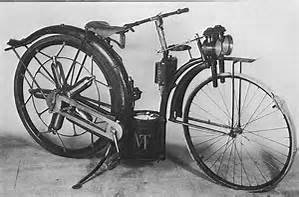There are two flavors of 'cylinders arranged radially around the crankcase' aircraft engines.
One is the traditional radial engine that we all are familiar with - where the crankcase (and cylinders) are stationary and the crankshaft revolves. The other is a rotary engine, in which the crankshaft is stationary and the engine rotates around it.
The rotary engine is simpler in theory, but it tends to have much more rotating mass than the radial engine. That increases the gyroscopic effect, but eliminates the need for a flywheel. It could adversely affect the handling of the airplanes it was installed in. On the positive side, they made fantastic power for the weight and displacement, and there was no reciprocating mass. So long as the crankcase and cylinders were balanced, it ran very smoothly. The downside was a near complete loss oiling system, the occasional mishap involving a cylinder departing company with the crankcase, and rather slow throttle response due to the sheer mass of rotating weight it was trying to accelerate or decelerate. And the mess.
The radial engine was the next evolutionary step. More complex, yes, but more reliable as the technology improved and capable of amazing levels of power output. My personal favorite is the Pratt & Whitney R-4360. 28 cylinders, 71 litres displacement, 56 spark plugs, 56 valves. Centrifugal supercharger, and a 2 barrel carburetor that could swallow a small child. Early models made around 3000hp at around 4,000 RPM, delivering around 4000 ft lbs of torque. Later models (some still in use, IIRC) can deliver nearly 4,000 hp by utilizing two huge honkin' turbochargers to force-feed the supercharger.

At the same RPM range, the later model engines crank out a bone pulverizing 5,000+ foot pounds of torque.
Think about that. Five. Thousand. Foot. Pounds.
I've had the incredible fortune to hear one start and run, with the huge dual turbos. It's a pants-crappingly *loud* engine, and even when it settles down into that beautiful loping idle, you can still feel it in your chest. When it's run up, it just gives you goosebumps.
That's one of my favorite memories.
 This is a 1912 Millet motorcycle. The cylinders rotate with the wheel.The gas tank is in the rear fender.It is believed to be the first motorcycle to use pneumatic tires.
This is a 1912 Millet motorcycle. The cylinders rotate with the wheel.The gas tank is in the rear fender.It is believed to be the first motorcycle to use pneumatic tires.
